Blog
4 Glues Every Workshop Should Have
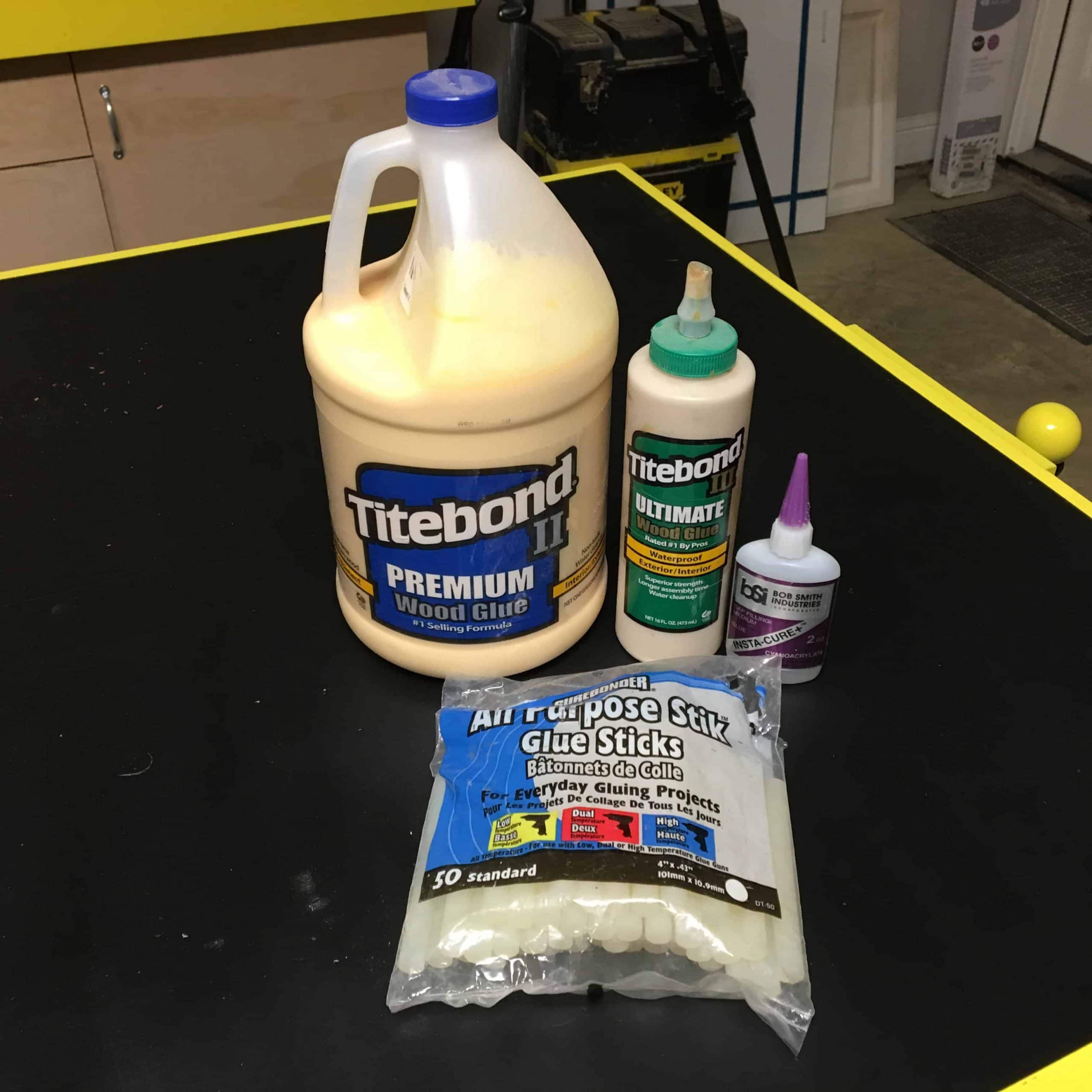
Glues are used in just about every workshop. Let’s talk about 4 glues every workshop should have! A visit to the local home improvement center will send you on your way with madness being unable to decide which glue to buy. The truth is, most of the glues on the shelf are all marketing. In this article we’re going to cut through the marketing and talk about the four basic glues you need for your workshop. There are some other glue that could be helpful and we’ll discuss those towards the end.
Glue #1: Yellow Wood Glue
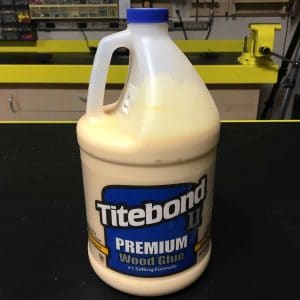 Yellow wood glue is the staple of pretty much every wood shop on the planet. It is definitely one of the glues every workshop should have! Without yellow glue you’re not going to be able to do many projects. Yellow glue is also known by the names Carpenter’s Glue, Wood Glue, or even by the brand name Elmer’s Glue (yes, the same guys who make the white glue you used in school!). In our case, we have chosen Titebond II, because that’s what was cheapest at the local home improvement center when we picked it up.
Yellow wood glue is the staple of pretty much every wood shop on the planet. It is definitely one of the glues every workshop should have! Without yellow glue you’re not going to be able to do many projects. Yellow glue is also known by the names Carpenter’s Glue, Wood Glue, or even by the brand name Elmer’s Glue (yes, the same guys who make the white glue you used in school!). In our case, we have chosen Titebond II, because that’s what was cheapest at the local home improvement center when we picked it up.
Yellow glue is perfect for most wood projects. It’s ideal for building furniture, cabinetry, games, and shop fixtures. Yellow glue is incredibly easy to clean up spills and squeeze out with water. I generally use a wet paper towel.
As for strength, you’ll find that after yellow glue dries it is stronger than the wood it glued together. It tacks fairly quickly (but can be slowed with additives).
The one downside of yellow glue is that its not water proof, and only somewhat water resistant. So if you’re making something that will be exposed to the elements, prone to dampness, or used to hold a liquid, read on.
Glue #2: Waterproof Yellow Glue
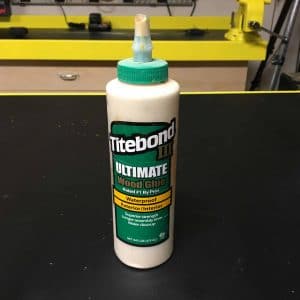 As mentioned before, standard yellow glue is not water proof. This means that yellow glue is not ideal for food serving trays, cutting boards, or outdoor furniture. There is good news! Several manufacturers make a waterproof “yellow glue”. It still cleans up with water until it cures which makes working with it no more complex than standard wood glue, but dries waterproof! The only reliable waterproof glue we’ve found is Titebond III, pictured here.
As mentioned before, standard yellow glue is not water proof. This means that yellow glue is not ideal for food serving trays, cutting boards, or outdoor furniture. There is good news! Several manufacturers make a waterproof “yellow glue”. It still cleans up with water until it cures which makes working with it no more complex than standard wood glue, but dries waterproof! The only reliable waterproof glue we’ve found is Titebond III, pictured here.
You might be asking yourself, why not just always use Titebond III over Titebond II. There are a couple of reasons that’s a bad idea:
- Price: Titebond III costs more than Titebond II. This increases the cost of our hobby, and provides no additional benefit to most projects.
- Staining: Titebond III has a nasty habit of leaving dark stains and discoloration in between bonded boards if you failed to wipe up all of the squeeze-out during assembly with a wet rag. This is not a factor with standard yellow glue Titebond II.
If you don’t need the waterproof element of Titebond III, we recommend sticking with the cheaper to buy, and easier clean-up of Titebond II. But that doesn’t mean Titbond III isn’t one the glues that every shop should have!
Glue #3: Cyanoacrylate Glue (CA Glue, Super Glue)
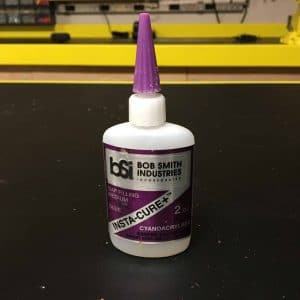 Cyanoacrylate glue, also known as CA Glue, or Super Glue is a fast acting glue. It’s the same stuff you’ve been using for years and its definitely one of the glues every workshop should have! The set time is incredibly short, so it bonds almost instantly in most cases. CA glue can be used with an accelerator (sometimes called an activator), that will speed up the cure time from a few seconds to instant. This is extremely handy when working batches and you don’t want to wait the 15-20 seconds for each piece. Use accelerators with caution however. Once the two pieces make contact, the bond is made. There is no chance for recovery if you misalign the components. In addition, applying too much accelerator will “water down” the CA glue, making for a weaker bond.
Cyanoacrylate glue, also known as CA Glue, or Super Glue is a fast acting glue. It’s the same stuff you’ve been using for years and its definitely one of the glues every workshop should have! The set time is incredibly short, so it bonds almost instantly in most cases. CA glue can be used with an accelerator (sometimes called an activator), that will speed up the cure time from a few seconds to instant. This is extremely handy when working batches and you don’t want to wait the 15-20 seconds for each piece. Use accelerators with caution however. Once the two pieces make contact, the bond is made. There is no chance for recovery if you misalign the components. In addition, applying too much accelerator will “water down” the CA glue, making for a weaker bond.
Why not use CA glue instead of yellow glue? CA glue is a brittle glue. It simply cannot handle the stress of twists and constant movement of the wood. It will eventually crack and your bond will fail. In addition, it is incredibly expensive compared to yellow glue. Lastly, CA glue is known for having a foul odor and fumes which make it less than enjoyable to work with for many, and unacceptable for others.
One great use of CA glue is to tack a project together while the yellow glue cures.
Glue #4: Hot Glue
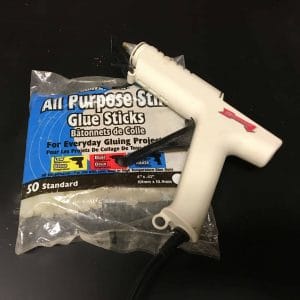 Hot glue rules. Hot glue is one of those all purpose glues that will you will find numerous uses for around your workshop. It’s not a good wood glue, and its not great for a permanent bond in many cases. But it is great for a lot of applications.
Hot glue rules. Hot glue is one of those all purpose glues that will you will find numerous uses for around your workshop. It’s not a good wood glue, and its not great for a permanent bond in many cases. But it is great for a lot of applications.
Hot glue is absolutely on the list of glues every workshop should have! Hot glue can be used to test fit parts for jigs. It can be used to hold all sorts of materials temporarily. It can be reheated with a heat gun, allowing you to remove or reset a bond. Some use it as a fast drying glue to hold parts bonded together with yellow glue while the yellow glue cures.
The only downside to hot glue is that it takes a while to get ready. When you need it, you’ll have to plug in your glue gun and wait about 5 minutes for the gun to come up to temperature. This can make it unsuitable when its not used very often. For others, their hot glue gun is always piping hot and ready to go.
Some Other Glues You Might Want to Keep in Stock
Spray Adhesive – I didn’t include spray adhesive as one of the glues every shop should have, but I generally keep a can of 3M Super 77 and a can of 3M Super 90 in my shop at all times. You never know when you’ll need to bond some laminate, leather, or cloth to a substrate. Spray adhesive is the only way to go in those situations. The other reason to have spray adhesive around is paper templates. With a tiny shot of Super 77 spray adhesive you can add the equivalent of post-it note glue to your paper templates. This allows you to cut out the pattern, and then easily remove the paper template form your material.
Polyurethane Glue – I didn’t include it as one the glues every workshop should have because I honestly have a hard time finding a use for it. But it does have one application it excels at: Bonding damp materials. Yellow glue can have difficulty curing if the wood is damp. This is especially true for pressure treated lumbers. Polyurethane glues will bond even when the material is wet. It’s also waterproof once cured. A common brand of polyurethane glue is Gorilla Glue.
So now you know the 4 glues every workshop should have!

Great article! It’s completely consistent with my experience, and no BS. A couple of small suggestions:
You might want to make readers aware that urethane glues like Gorilla have a fairly short shelf life. I ended up throwing away most of the first bottle I bought.
Another glue to consider having around is something in the contact cement category. The new low-odor versions are much less toxic, and there’s nothing better for gluing things like leather.
Last but not least, I use epoxies a lot. There are now very sophisticated epoxy wood fillers that make repair of rotted wood feasible, thus permitting repair of historic window sash, for instance. Abatron makes a very good (but expensive) epoxy system for repairing rotted wood. Bondo does too, but it doesn’t have a good reputation compared to Abatron.
Titebond II vs.Titebond III:
FWIW, these both operate on opposing principles. TBII sets by **releasing** moisture. TBIII sets by **absorbing** moisture. Hence, TBII does not work well if you are in a humid environment, such as, say, Florida, Louisiana, or parts of Texas. In FL, I’ve had glue-ups setting for 48h, with TBII, and they just pulled apart easily when any tension was placed on them. Under the same circumstances, TBIII was rock solid. I have no experience, but I’m guessing the opposite is true for dry places like Arizona or Nevada.
Another thing to realize about TBIII is that it foams as it sets, so you will almost certainly need to do some cleanup no matter how careful you are about wiping away excess, unless your gluing area doesn’t need to be anywhere near the edges.